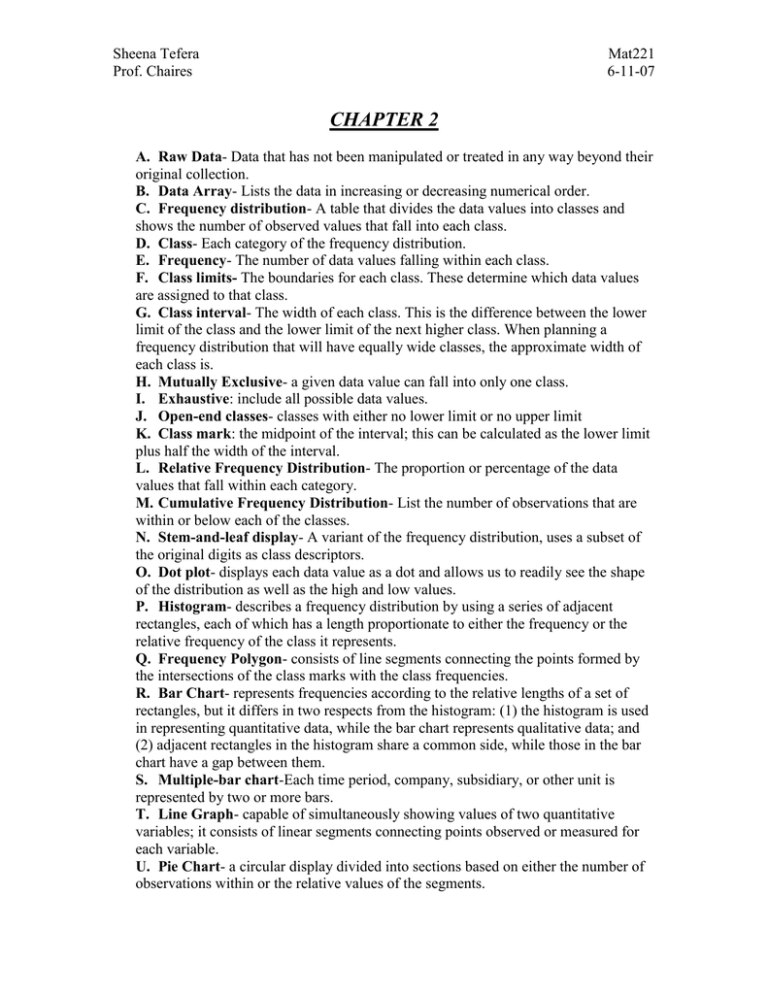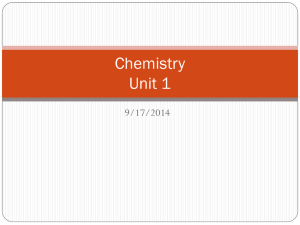CHAPTER 2
advertisement

Sheena Tefera Prof. Chaires Mat221 6-11-07 CHAPTER 2 A. Raw Data- Data that has not been manipulated or treated in any way beyond their original collection. B. Data Array- Lists the data in increasing or decreasing numerical order. C. Frequency distribution- A table that divides the data values into classes and shows the number of observed values that fall into each class. D. Class- Each category of the frequency distribution. E. Frequency- The number of data values falling within each class. F. Class limits- The boundaries for each class. These determine which data values are assigned to that class. G. Class interval- The width of each class. This is the difference between the lower limit of the class and the lower limit of the next higher class. When planning a frequency distribution that will have equally wide classes, the approximate width of each class is. H. Mutually Exclusive- a given data value can fall into only one class. I. Exhaustive: include all possible data values. J. Open-end classes- classes with either no lower limit or no upper limit K. Class mark: the midpoint of the interval; this can be calculated as the lower limit plus half the width of the interval. L. Relative Frequency Distribution- The proportion or percentage of the data values that fall within each category. M. Cumulative Frequency Distribution- List the number of observations that are within or below each of the classes. N. Stem-and-leaf display- A variant of the frequency distribution, uses a subset of the original digits as class descriptors. O. Dot plot- displays each data value as a dot and allows us to readily see the shape of the distribution as well as the high and low values. P. Histogram- describes a frequency distribution by using a series of adjacent rectangles, each of which has a length proportionate to either the frequency or the relative frequency of the class it represents. Q. Frequency Polygon- consists of line segments connecting the points formed by the intersections of the class marks with the class frequencies. R. Bar Chart- represents frequencies according to the relative lengths of a set of rectangles, but it differs in two respects from the histogram: (1) the histogram is used in representing quantitative data, while the bar chart represents qualitative data; and (2) adjacent rectangles in the histogram share a common side, while those in the bar chart have a gap between them. S. Multiple-bar chart-Each time period, company, subsidiary, or other unit is represented by two or more bars. T. Line Graph- capable of simultaneously showing values of two quantitative variables; it consists of linear segments connecting points observed or measured for each variable. U. Pie Chart- a circular display divided into sections based on either the number of observations within or the relative values of the segments. Sheena Tefera Prof. Chaires Mat221 6-11-07 V. Pictogram- Uses symbols instead of a bar describing frequencies or other values of interest. W. Sketch- A drawing or pictorial representation of some symbol relevant to the data. X. Scatter diagram or Scatterplot- Used to examine whether a relationship exists Tabulation- Counting how many people or items are in each category or combination of categories. Y. Simple tabulation- Count how many people or items are in each category Z. Cross-tabulation- shows how many people or items are in combinations of categories. Chapter 4 A. Exploratory Research- Helps to become familiar with the problem situation, identify important variables, and use these variables to form hypothesis that can be tested in subsequent research. B. Descriptive Research- The goal of describing something. C. Causal research- To determine whether one variable has an effect on another. D. Predictive research- attempts to forecast some situation or value that will occur in the future. E. Primary data- Refers to those generated by a researcher for the specific problem or decision at hand. F. Secondary data- Data gathered by someone else for some other purpose. G. Mail survey- A mailed questionnaire typically accompanied by a cover letter and a postage-paid return envelope. H. Personal Interview- An interviewer personally secures the respondents cooperation and carries out what could be described as a “purposeful conversation” in which the respondent replies to the questions asked of her. I. Telephone interview- Similar to the personal interview, but uses the telephone instead of personal interaction. J. Questionnaire- The data collection instrument. K. Multiple Choice- Several alternatives in which to choose. L. Dichotomous- Having only two alternatives available. M. Open-ended- The respondent is free to formulate his or her own answer and expand on the subject of the question. N. Sampling error- Errors due to survey research. O. Nonsystematic: Measurements exhibiting random error are just as likely to be too high as they are to be too low. P. Response or non-response errors- Both of the directional, or systematic type. Q. Experiments- Purpose is to identify cause and effect relationships between variables. R. Internal Validity- Whether T really made the difference in the measurements obtained. S. External validity- Whether the results can be generalized to other people or settings. T. Observation- Relies on watching or listening, then counting or measuring. Sheena Tefera Prof. Chaires Mat221 6-11-07 U. Population: The set of all possible elements that could theoretically be observed or measured; this is sometimes referred to as the universe. V. Probability sampling- Each person or element in the population has a known chance of being included in the sample. W. Nonprobability sampling- Primarily used in exploratory research studies where there is no intention of making statistical inferences from the sample to the population. X. Simple random sample- Every person or element in the population has an equal chance of being included in the sample. Y. Systematic sample- Randomly select a starting point between 1 and k, then sample every kth element from the population. Z. Periodicity- A phenomenon where the order in which the population appears happened to include a cyclical variation in which the length of the cycle is the same as the value of k that we are using in selecting the sample. A. Stratified sample- The population is divided into layers, or strata; then a simple random sample of members from each stratum is selected. B. Cluster Sample- Involves dividing the population into groups, then randomly selecting some of the groups and taking either a sample or a census of the members of the groups selected.



![study_design_summaries[1]. - DPT-Stats-in-PT](http://s3.studylib.net/store/data/008944321_1-58dbe27b313caaad548a0c6d42476993-300x300.png)

